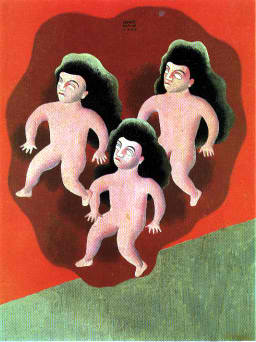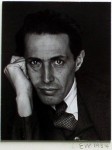
Carlos Mérida
Guatemalan, 1891-1984 (active Mexico)
Fuga (Escape), 1940
oil on canvas
15 7/8 x 12 in.
SBMA, Gift of Mrs. MacKinley Helm
1969.35.25

Carlos Mérida, 1934, photo by Edward Weston
COMMENTS
Carlos Merida is not Mexican by birth, but he is, rather more than Jean Charlot, Mexican in genre. He was, indeed, the first painter to exhibit in Mexico work of indigenously Latin-American character. He was born in Guatemala in 1893. [I used the date Diana gives above rather than this one.] His father was pure Maya stock from the Maya-Quiché district, and his mother was a Zapotecan Indian with a single remote priestly ancestor from Spain. Hence his origins are not unlike those of Indian painters born in Mexico; except that his immediate famly was in possession of ampler means. He seems to have begun to walk, talk, paint, and play the piano at about the same time. At the age of ten, with a show of precocity not uncommon in the southern countries, he decided to make his vocation in music.
For six years he worked assiduously at piano, musical theory and composition. Then he picked up a catarrhal infection which resulted in an incurable degree of deafness. To comfort himself for the loss of a promising career he took up painting again. He often speaks of his work in musical terms. Even the titles of his pictures sometimes show that he has been thinking in terms of musical composition: for example,"Ten Variations on an Ancient Maya Motive" and "Ten Plastic Inventions on the Theme of Love," the work of 1939. [Clearly this also applies to our work Fuga or Fugue, a contrapuntal musical composition in which different voices or parts enter successively in imitation of each other, as the three figures in Fuga imitate and repeat one another.]
In 1910 Mérida went with a Guatemalan companion to Paris, lived in the Latin quarter, went about to cafés and smoked marihuana cigarettes with Amadeo Modigliani. He and his friend had read together, in Guatemala, some books about Impressionism and Cubism, and had gone to Paris to see for themselves what was going on. They had the misfortune, as more than one Mexican painter has had in his time, to meet European artists in cafés rather than studios. They were bewildered and shocked by the egotism and brittleness of the talk they heard there. Mérida's companion, in a fit of depression, killed himself. Fresh from Catholic schools, Carlos was afraid to commit suicide, although he says he wanted to. Determined to recover his equilibrium in work, he went for lessons to Modigliani, Van Dongen and the Spanish painter, Angel de Camarasa. With the thought of his friend's death always fresh in his mind, he worked furiously at the production, so he says, of reflections of the works of his teachers.
For a reason which was never explained to him he was arrested by the United States Military police in New York, on his way back to Guatemala, and detained until diplomatic forces intervened to free him.
Excerpt from:
MacKinley Helm, Modern Mexican Painters, Dover, NY, 1941, pp. 158-162.
SBMA CURATORIAL LABELS
At the age of seventeen, Carlos Mérida traveled to Paris for four years of study, befriending Pablo Picasso and Amedeo Modigliani. Upon his return to Guatemala, the artist, of Maya- Quiché descent, joined artist Rafael Yela Günther to promote a pro-Indian movement in the arts, informing modern art with pre-Columbian concepts. Unable to rouse interest in Guatemala, Mérida moved to Mexico, where he found a public more receptive to his folkloric yet modern imagery.
During World War II, Mexico City became a haven for an international group of Surrealist artists and writers seeking toescape the ravages of war. Their creative and intellectual activity culminated in the journal Dyn and in the landmark International Exhibition of Surrealism held at the Galería de Arte Mexicano in Mexico City in 1940, both of which featured work by Mérida.
In their small scale, inflated volumes, and simplified features, the three figures in Fuga and those in Sky No. 1 are modeled after Tlatilco figurines. Artist and ethnographer Miguel Covarrubias led the first controlled excavation of the Tlatilco site in the Valley of Mexico, publishing photographs and archaeological illustrations in Dyn in 1943. However, the figures also resemble the biomorphic forms of Surrealists Joan Miró and Roberto Matta.
SBMA title card, 2013
Before Mexico became a destination for European Surrealists seeking refuge from World War II, Carlos Mérida had already been to Paris. Accordingly, he was prepared for and receptive to the Surrealist activity that flourished in Mexico in the late 1930s and early 1940s, highlighted by the landmark International Exhibition of Surrealism which was held in Mexico City in 1940 and included his work.
Mérida’s Fuga represents how he re-invented Surrealism’s concept of metamorphosis and abstraction in terms of indigenous perspectives. In their small scale, inflated volumes, and simplified surfaces, these subjects are modeled after pre-Columbian figurines. The work’s title appears to be a double entendre, referring to both the musical term “fugue” and to “flight” or “escape”. The depicted triad may be an allusion to exiles André Breton, Wolfgang Paalen, and César Moro, the three organizers of the International Exhibition of Surrealism.
Through his art and writing during the 1910s, Carlos Mérida fostered a pro-indigenous movement in his native Guatemala, a project which ultimately brought him to Mexico in 1920. From the Mexican government, Mérida received a stipend to study indigenous art, which soon resulted in his active participation in the mural movement. Along with the younger Manuel Álvarez Bravo, Mérida also became involved with Frances Toor’s Mexican Folkways, a review which contributed to a growing cultural and aesthetic interest in native folk art.
…[A]s demonstrated by his painting Fuga (Escape/Fugue)…and his participation in the 1940 International Exhibition of Surrealism at the Galeria de Arte Mexicano, Mérida was likewise instrumental in promoting indigenous are within Mexico’s Surrealist circle.
…Born in Guatemala in 1891 of a pure Mayan father (his mother’s family came from Oaxaca), Carlos Mérida traveled to study in Paris in 1910; however, he lived most of his life in Mexico City. Fauvism initially influenced his work, but it was Cubism which had the greater impact. Later Klee and Miro provided inspiration for his stylistic development as well as the work of Diego Rivera and the Mexican muralists.
…Fuga presents the fusion of these influences along with the power of music in his life. From early childhood he showed promise as both an artist and musician, and at ten he decided to dedicate himself to piano and composition. When an infection robbed him of his hearing at sixteen, he turned to art, which he says he always felt to be in part a musical expression. Three figures (movements) are common to his images. Fuga no only means the musical “fugue” (variations on a theme) but also means “flight”. The fleeing, dancing figures seem frozen in a moment of ritual movement, depicted in the distinctive flat color forms that have become a signature of Mérida’s work. He captures the paradox we often experience in viewing ancient images: decorative/serious, playful/threatening, naïve/worldly. His re-creation of the images and ideas of his ancestors, a pursuit he followed until his death in 1984, has provided a vision to our century that was hitherto known only to archeologists. He paints like a Mayan might conceivably paint today.
John Palmer Leeper, Director, Marion Koogler McNay Art Institute, San Antonio, Texas
- SBMA Wall Text, 2000
